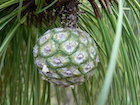Conservation Status

Pinus luzmariae
Pérez de la Rosa 1998
Common names
Luz Maria pine, three-needled egg-cone pine (Debreczy and Rácz 2011), pino trompillo de tres hojas (Pérez de la Rosa and Farjon 2013).
Taxonomic notes
Synonymy:
- Pinus oocarpa Schiede ex Schltdl. f. trifoliata Martínez 1945, nom inval.;
- Pinus oocarpa Schiede ex Schltdl. var. trifoliata Martínez 1948.
Type collection Durango, Mexico: Sierra de Chavarria, M. Martínez 3458 (holotype MEXU).
This is one of three pine species (P. jaliscana, P. luzmariae and P. vallartensis) described by Pérez de la Rosa that were formerly treated as infrageneric taxa of P. oocarpa. Although all three species are still regarded as part of the large and diverse subsection Australes, molecular analysis of this group suggests that the closest relative of P. luzmariae is another rare pine of Jalisco, P. georginae, and that other close relatives include the Mexican pines P. lawsonii, P. patula, P. tecunumanii, P. lumholtzii, P. teocote, and P. herrerae, all reflecting a common ancestor about 3 million years ago; P. oocarpa appears to be sister to this clade (Hernández-León et al. 2013). All of these species share similar climate and ecological setting, look very similar, and have similar geographic distributions within Mexico.
Description
Trees to 18 m tall and 60 cm dbh with an irregular, columnar or sparsely branched, umbellate crown. Bark on mature trees very scaly, irregularly longitudinally fissure, red-brown in crevices, turning gray with age. Twigs 4-5 mm thick, finely scaly, reddish- to light-brown. Leaves in fascicles of 3, straight, stiff, drooping in 2nd and 3rd years; (11-)14-17(-29) cm long, 1.2-1.6 mm wide. Seed cones conical-ovoid, remarkably smooth when closed, 3-5.5 × 2-5(-6) cm when open, wider than long when open, pendant on thin (2-4 mm) 1-2.5 cm long stalks; basal cone scales detach before the cones fall (a rare character); serotinous, persistent for a few years (Farjon 2010, Debreczy and Rácz 2011).
In general appearance it resembles the sympatric P. lumholtzii, which has very different cones, thick twigs (ca. 10 mm), and shorter needles in bundles of 5 (Debreczy and Rácz 2011).
Distribution and Ecology
Mexico: Durango and Jalisco, at 1,600 to 2,500 m (Debreczy and Rácz 2011). However, the Conifers of the World database (accessed 2019.02.24) also reports collections from Nayarit, Oaxaca, Michoacan, and Intibuca, Honduras; the Oaxaca collections are especially numerous, accounting for half of all the records. Climate temperate, with subtropical influence (Perez de la Rosa and Farjon 2013). In Durango P. luzmariae occurs with P. devoniana at low elevations, and more generally with P. engelmannii, P. lumholtzii and P. yecorensis, and sometimes P. oocarpa; angiosperm associates include, on rocky sites, Quercus magnoliifolia, Q. resinosa, Q. crassifolia, Q. coccolobifolia, and, in deeper soils, Q. viminea, Q. fulva, and Arbutus tessellata (Debreczy and Rácz 2011, García and González 2003).
Although its conservation status is "least concern", it does have a decreasing population trend due to a low number of fertile seeds per cone. This is possibly because the pollen is released in the months of June and July, when it rains more, making pollination difficult. Secondary threats are fire and illegal logging for firewood (Perez de la Rosa and Farjon 2013).
Remarkable Specimens
Ethnobotany
Observations
I haven't seen this species in habitat; if I were to go looking, the detailed location descriptions in the Conifers of the World database appear sufficient to locate it at a number of sites.
Remarks
The epithet remembers Pérez de la Rosa's village school teacher Luz Maria Villareal de Puga, who first taught him about plants (Farjon 2010).
Citations
Debreczy, Z. and I. Rácz. 2011. Conifers Around the World. Vols. 1-2. Budapest: DendroPress Ltd.
Farjon, Aljos. 2010. A Handbook of the World's Conifers. Leiden, Netherlands: Brill Academic Publishers.
García, A. and González, M. S. 2003. Pináceas de Durango. 2nd Ed. Instituto de Ecología A. C. CONAFOR.
Hernández-León, Sergio, David S. Gernandt, Jorge A. Pérez de la Rosa, and Lev Jardón-Barbolla. 2013. Phylogenetic relationships and species delimitation in Pinus section Trifoliae inferrred from plastid DNA. PLOS One DOI: 10.1371/journal.pone.0070501.
Pérez de la Rosa, J. A. 1998. Promoción de una variedad de pino serotino mexicano a nivel de especie. Boletín del Instituto de Botánica 5:127-135 (p. 127).
Perez de la Rosa, J. and A. Farjon. 2013. Pinus luzmariae. The IUCN Red List of Threatened Species 2013: e.T42378A2976301. http://dx.doi.org/10.2305/IUCN.UK.2013-1.RLTS.T42378A2976301.en, accessed 2019.02.24.
See also




